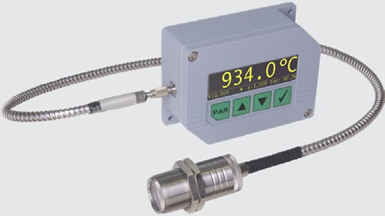KPM Analytics introduces noncontact infrared temperature sensor for industrial automation, R&D
Rugged and flexible PSC-GRF11N pyrometer facilitates measurement of four temperature ranges, spans induction heating, heat treating, steel, composites and ceramics applications.

Photo Credit: KPM Analytics
Process Sensors IR Temperature Measurement (Franklin Lakes, N.J., U.S.), a KPM Analytics’ (Westborough, Mass., U.S.) brand, introduce its newest fiber optic two-color pyrometer, Model PSC-GRF11N, for industrial automation and R&D applications. This digital ratio pyrometer series is designed for lower starting temperature measurements beginning at 300°C (572°F). Four temperature ranges are offered: 300 to 1,100°C, 350 to 1,300°C, 400 to 1,600°C and 500 to 2300°C. The Model PSC-GRF11N operates in ambient temperatures up to 250°C (482°F) and is said to be immune to high magnetic frequencies encountered in manufacturing facilities.
Independent of emissivity, the two-color pyrometer spans a wide range of demanding industrial applications including induction heating, heat treating, steel, composites and ceramics, as well as semiconductor processes. According to KPM Analytics, the 5-ms response time of the PSC-GRF11N is ideal for quick measurement processes. A selection of variable focus fiber optic lenses provides small spot sizes from 0.7 mm in diameter.
The noncontact infrared temperature sensor uses an integrated laser that provides precision aiming onto the center of the target. The linear temperature output signal of 4-20 mA reportedly simplifies installation of the PSC-GRF11N into existing measurement and control systems. Each device is equipped with a galvanically isolated RS-485 Modbus RTU interface, enabling parameter setting and software evaluation in bus systems as well.
PSC-GRF11N’s rugged and flexible stainless steel fiber optic cable and lens assembly facilitates operation in the most demanding environmental conditions, the company conteds. Its brightly colored on-board temperature display is easily viewed at a long distance, even in less-than-ideal conditions. All the sensor’s parameters are entered using push buttons and are displayed on the electronics housing. The operator-friendly PSCSpot for Windows software for IR sensor parameterization and software evaluation is used from a PC.
PSCSpot for Windows software is standard and is provided for storage, processing and evaluation of real-time measured data. It provides extensive statistical analysis of data, export of measured data as test files and creates Microsoft Excel spreadsheets. The software also provides an integrated report function with customized templates for Microsoft Word and an integrated calculator for easy calculation of optics parameters.
The PSC-GRF11N lends itself to a full range of fiber optic cables, and distinctive electrical, mechanical and optical companion accessories that simplify harsh installation conditions, sighting and mounting for reliable and accurate measurements.
The Process Sensors IR Temperature Measurement Division offers noncontact infrared temperature measurement sensors, including thermal imaging camera systems and blackbody calibration sources. Technical and application support is provided globally through direct, regional and sales representative offices.
Related Content
-
ST Engineering MRAS presents initiatives to drive autoclave efficiency, automation
During a JEC World 2024 panel discussion, the company revealed ways in which it is maximizing throughput and efficiency of its autoclaves and enhancing composites production processes.
-
Aerotech Academy Puglia is inaugurated at Leonardo Aerospace site in Grottaglie, Italy
Joining the Leonardo MaTeRIA Lab and Joint Lab with Syensqo, this aerostructures training course will be 75% materials science and structural design/analysis, 25% digital transformation and AI.
-
Com&Sens presents workshop on fiber optic sensing for COPVs
Three-day hands-on workshop from June 11-13 in Leuven, Belgium, will equip participants with a better understanding of fiber optic sensing technology for digital manufacturing of composite tanks.
















